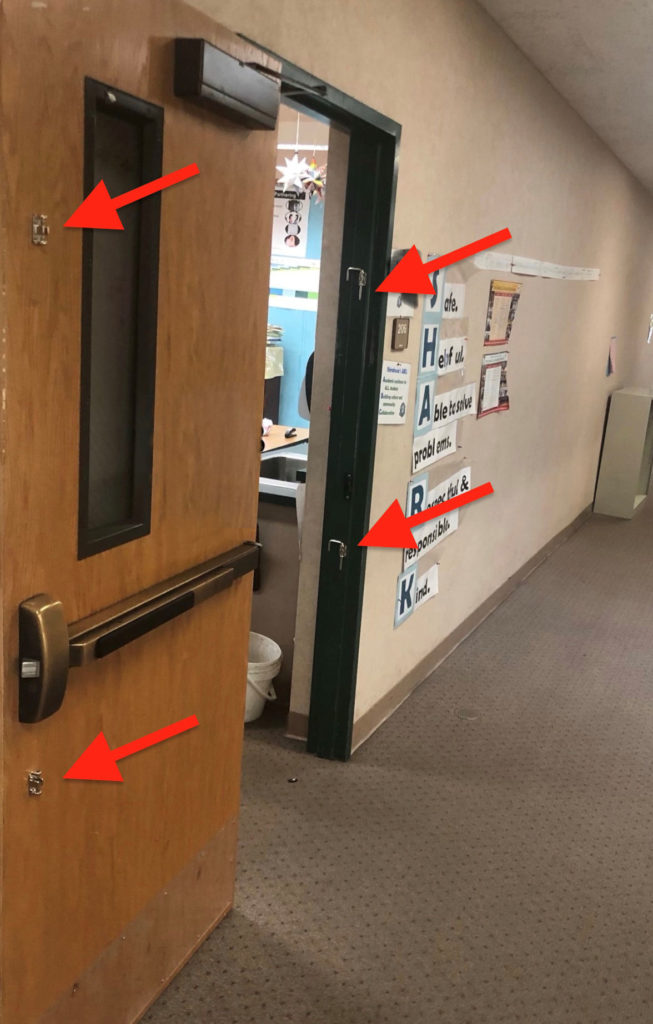 I received this photo recently, and I think it deserves more than a Wordless Wednesday or Fixed-it Friday post. This is not the type of photo that I can stay wordless about.
I received this photo recently, and I think it deserves more than a Wordless Wednesday or Fixed-it Friday post. This is not the type of photo that I can stay wordless about.
This is a door in a school, and it’s a fire door assembly. The existing fire exit hardware can not be locked down from inside of the room, so the two hooks were added on the frame and the retainers on the door.
Thanks to a serendipitous meeting between a door hardware consultant / fire door inspector, and the facility manager for the school district, the doors in this school are currently being made code-compliant again. The consultant donated 40 hours of his time to make this school right (kudos to you!).
It scares me to think about trying to release these latches for egress with even a minimal amount of sideload pressure on the door. Someone would also have to know how to release the latches, and that three operations must be performed – in the correct order.
There has been a lot of talk about accessibility with regard to classroom barricade devices, and the laws in several states that have been created to allow the devices, despite the requirements of the adopted codes. The extra latches on this classroom door would require tight grasping, pinching, and possibly twisting of the wrist to operate. They also look like they are mounted outside of the allowable mounting height range (this school is in California so the range is 34-44 inches above the floor). Because these latches are permanently mounted on the door, they are considered operable parts, and would not be compliant with the ADA Standards for Accessible Design or with ICC A117.1 Accessible and Usable Buildings and Facilities.
But what if the school had purchased a barricade device that is not permanently mounted on the door? Proponents of barricade devices say that these temporary devices are compliant with the ADA. While it’s true that if a device is not mounted on the door, it’s not considered an operable part, that doesn’t mean that it meets the intent of the ADA. If a person with a disability is unable to operate the device, that seems like a problem to me – whether the device is permanently or temporarily mounted on the door.
 There are plenty of code-compliant locks and panic hardware that will provide the necessary level of security – far beyond what the retrofit latches on this door will withstand. The problem is, once a school district realizes that they have invested in retrofit security that is not code-compliant, the district may ask their state legislators to sponsor a bill that legalizes the devices they have purchased.
There are plenty of code-compliant locks and panic hardware that will provide the necessary level of security – far beyond what the retrofit latches on this door will withstand. The problem is, once a school district realizes that they have invested in retrofit security that is not code-compliant, the district may ask their state legislators to sponsor a bill that legalizes the devices they have purchased.
Rather than figuring out how to use the legislative process to circumvent the adopted codes, why aren’t state legislators considering the reasons behind the code requirements that are created to keep building occupants safe? These codes are based on 100+ years of experience, and represent the consensus of hundreds of stakeholders. Just because a law CAN override these regulations, doesn’t mean that it SHOULD.
We are currently working with code officials in several states to help legislators and others understand the potential unintended consequences of retrofit security devices. If you see a bill in your state legislature related to barricade devices, please get me involved.
You need to login or register to bookmark/favorite this content.





I do not understand what the problem is with schools not understanding that if you want a multi-point locking system just install a Von Duprin 9957 series panic. They already have a panic on this door. I have tried to get thru a 9957 during a demo of a retail store that had that on a back entrance and it was next to impossible. It took over 30 minutes and a large breaker bar (it was on a steel stiffened HM door). The installer had done his job well. Is this just to simple of a fix?
I’m guessing it has to do with the cost. 🙁
– Lori
Lori,
it is amazing the things you see in our trade. I was opening our Flying Locksmith St Louis location. We made a sales call on a private high school. The facility manager told us we were to late he had just updated all new levers and had a master key system installed by a general contractor. I asked to see the doors. All new levers installed and slide bolts installed about 18 inches from the ground. I mentioned to the facility manager about egress and he said, “I have a good relationship with the fire marshal, we’re all set.”
🙁
Too many decisions made on emotions rather than logic!
Those “hooks” appear to be import knockoffs of the Engert’s patio door security latch. That made in the USA device is described as the ‘easiest-to-use most dependable lock for sliding glass doors, the best patio door lock in America, used by every major hotel chain nationwide’. The original is made by The Harry Engert Co., Inc. of Skokie, IL, and come in 16 variations of shackle width and finish. We have used them for the proper application and they work fine. This is certainly an off-label use that they were never intended or designed for! I’m very happy to hear that this unlawful Jerry rigged application has been discontinued and the doors are being made code-compliant.
No one cares until tragedy strikes then the whole world sits ups and takes notice and says WHY … Then the law suits start to pile up and everyone starts pointing fingers … So sad our society only cares about money . Auto companies are famous for this … They value human life at just over $250,000 . About the cost of a settlement. However jury’s can and do award more . So they take a chance .
Lori, I would love to hear how the consultant was able to convince the facility manager to meet with him. I’ve reached out to two school principals and they have no interest. Shortly afterwards, one of the schools had a serious threat made against it and I attended a meeting at which the superintendent of the district and the chief school security officers attended. I waited to meet with them and introduced myself and offered my time to evaluate the doors/hardware and/or walk with them to teach them what to look for. They blew me off and said they know what they’re doing and have plans to keep the kids safe. While I haven’t found any violations at this point, I have found classroom locks that only lock from the corridor side. I addressed this with them and, again, they blew it off. They are ALL retired police officers. I seriously doubt they know a great deal about hardware and/or life safety as it relates to hardware. It is very frustrating.
BTW….the guy that made the threat was eventually held with 1.5 million bond due to other things found while investigating him. If it had been only the threat on the school, he would be back, living in a house right beside the school playground. The same playground he threatened to shoot-up.
Hi Eric –
I talked to the consultant about your question. Here’s what he said:
“I continue to ingratiate myself with the school district and their stake-holders. I was lucky in that the building superintendent was educated on the building, fire, and life-safety codes. Being seen as an ally vs an opportunist is the 1st step to building the relationship with the district. That said, my initial on-site meeting with this district was only minutes after the local police department had just finished an active shooter Q&A telling the teachers to ‘have barricade devices at the doors ready to go.’
I recommend the long process of building the relationship with the district and all stakeholders. This may include offering door & hardware educational classes through local channels. Perhaps the local dhi chapter can put on an open house with break-out education sessions focused on hardware installation, application and code classes. If your dhi chapter is having a meeting and the guest speakers topic covers school security, invite anyone and everyone you can from your area especially the local fire department, school maintenance department, principals, PTA, and teachers!
Remember that the ‘perfect solution’ for any school or school district can only be realized as a result of everyone contributing their particular expertise to the big picture. It will be a marathon not a sprint.”
– Lori